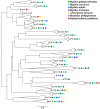The Evolution and Diversity of Interleukin-17 Highlight an Expansion in Marine Invertebrates and Its Conserved Role in Mucosal Immunity
- PMID: 34386003
- PMCID: PMC8353272
- DOI: 10.3389/fimmu.2021.692997
The Evolution and Diversity of Interleukin-17 Highlight an Expansion in Marine Invertebrates and Its Conserved Role in Mucosal Immunity
Abstract
The interleukin-17 (IL-17) family consists of proinflammatory cytokines conserved during evolution. A comparative genomics approach was applied to examine IL-17 throughout evolution from poriferans to higher vertebrates. Cnidaria was highlighted as the most ancient diverged phylum, and several evolutionary patterns were revealed. Large expansions of the IL-17 repertoire were observed in marine molluscs and echinoderm species. We further studied this expansion in filter-fed Mytilus galloprovincialis, which is a bivalve with a highly effective innate immune system supported by a variable pangenome. We recovered 379 unique IL-17 sequences and 96 receptors from individual genomes that were classified into 23 and 6 isoforms after phylogenetic analyses. Mussel IL-17 isoforms were conserved among individuals and shared between closely related Mytilidae species. Certain isoforms were specifically implicated in the response to a waterborne infection with Vibrio splendidus in mussel gills. The involvement of IL-17 in mucosal immune responses could be conserved in higher vertebrates from these ancestral lineages.
Keywords: IL-17; comparative genomics; comparative immunology; cytokines; evolution; interleukin; mucosal immunity; mussel.
Copyright © 2021 Saco, Rey-Campos, Rosani, Novoa and Figueras.
Conflict of interest statement
The authors declare that the research was conducted in the absence of any commercial or financial relationships that could be considered as a conflict of interest.
Figures







Similar articles
-
IL-17 signaling components in bivalves: Comparative sequence analysis and involvement in the immune responses.Dev Comp Immunol. 2015 Oct;52(2):255-68. doi: 10.1016/j.dci.2015.05.001. Epub 2015 May 27. Dev Comp Immunol. 2015. PMID: 26026244
-
Comparative study of immune responses in the deep-sea hydrothermal vent mussel Bathymodiolus azoricus and the shallow-water mussel Mytilus galloprovincialis challenged with Vibrio bacteria.Fish Shellfish Immunol. 2014 Oct;40(2):485-99. doi: 10.1016/j.fsi.2014.07.018. Epub 2014 Aug 1. Fish Shellfish Immunol. 2014. PMID: 25089010
-
Genome-wide identification of interleukin-17 (IL-17) / interleukin-17 receptor (IL- 17R) in turbot (Scophthalmus maximus) and expression pattern analysis after Vibrio anguillarum infection.Dev Comp Immunol. 2021 Aug;121:104070. doi: 10.1016/j.dci.2021.104070. Epub 2021 Mar 21. Dev Comp Immunol. 2021. PMID: 33757802
-
IL-17: overview and role in oral immunity and microbiome.Oral Dis. 2017 Oct;23(7):854-865. doi: 10.1111/odi.12598. Epub 2016 Dec 27. Oral Dis. 2017. PMID: 27763707 Free PMC article. Review.
-
Genomics and immunity of the Mediterranean mussel Mytilus galloprovincialis in a changing environment.Fish Shellfish Immunol. 2019 Jul;90:440-445. doi: 10.1016/j.fsi.2019.04.064. Epub 2019 Apr 30. Fish Shellfish Immunol. 2019. PMID: 31048040 Review.
Cited by
-
Identification of Crustacean Female Sex Hormone Receptor Involved in Sexual Differentiation of a Hermaphroditic Shrimp.Biomolecules. 2023 Sep 27;13(10):1456. doi: 10.3390/biom13101456. Biomolecules. 2023. PMID: 37892140 Free PMC article.
-
Evolutionary insights into toxins diversity in Ceriantharia (Cnidaria; Anthozoa).Toxicon X. 2025 Jun 4;27:100227. doi: 10.1016/j.toxcx.2025.100227. eCollection 2025 Sep. Toxicon X. 2025. PMID: 40552252 Free PMC article.
-
γδ T, NKT, and MAIT Cells During Evolution: Redundancy or Specialized Functions?J Immunol. 2022 Jul 15;209(2):217-225. doi: 10.4049/jimmunol.2200105. J Immunol. 2022. PMID: 35821101 Free PMC article. Review.
-
Clues from planarians about interleukin-17A and stress that result from light avoidance: IL-17A antagonists reduce defensive responding in flatworms.Cytokine. 2023 Oct;170:156345. doi: 10.1016/j.cyto.2023.156345. Epub 2023 Aug 23. Cytokine. 2023. PMID: 37625214 Free PMC article.
-
Editorial: Women in cytokines and soluble mediators in immunity.Front Immunol. 2024 Mar 14;15:1395165. doi: 10.3389/fimmu.2024.1395165. eCollection 2024. Front Immunol. 2024. PMID: 38550586 Free PMC article. No abstract available.
References
-
- Malagoli D. Cytokine Network in Invertebrates: The Very Next Phase of Comparative Immunology. Invertebr Surviv J (2010) 7:146–8.
Publication types
MeSH terms
Substances
Supplementary concepts
LinkOut - more resources
Full Text Sources
Miscellaneous

